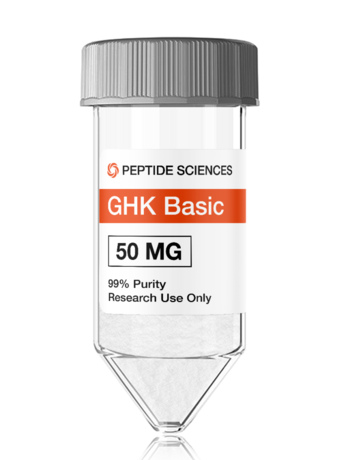GHK Basic 50 mg
GHK is a tripeptide with the amino acid sequence glycyl-histidyl-lysine. In nature, it is found in human plasma, saliva, and urine. In plasma, the level of GK is about 200 ng/ml at the age of 20 years, but it drops to 80 ng/ml by the age of 60. Such a decrease in the level of GHK coincides with a noticeable decrease in the body's regenerative ability. Scientific studies have shown that GK can promote wound healing, fight infections, hair growth, cancer, cognitive health, and the use of facial cosmetics.
What is the difference between GHK and GHK-Su?
GHK with and without copper affects a large number of genes associated with the body's response to stress and trauma (tissue remodeling, antioxidant, anti-inflammatory, anti-pain, anti-anxiety, blood vessel growth, nerve growth, anti-cancer effects). action). The GHK sequence is included in the collagen molecule, and SPARC and GK proteins are naturally released after injury due to protein breakdown.
Copper — a transition metal vital for all eukaryotic organisms, from microbes to humans. Since it can be converted from the oxidized form of Cu(II) to the reduced form of Cu(l), it acts as an important cofactor in many biochemical reactions involving electron transfer. A dozen enzymes use changes in the oxidation state of copper to catalyze important biochemical reactions, including cellular respiration, antioxidant defense, detoxification, blood clotting, and connective tissue formation. Copper is necessary for iron metabolism, oxygenation, neurotransmission, embryonic development and many other important biological processes.
HCK Research
1. GHK suppresses the synthesis of fibrinogen.
Fibrinogen consists of three polypeptide chains; alpha, beta and gamma.
GHK strongly suppresses the fibrinogen beta chain gene. The absence of a sufficient amount of FGB will effectively stop the synthesis of fibrinogen, since the production of fibrinogen requires equal amounts of all three polypeptide chains.
GHK also suppresses the production of the inflammatory cytokine interleukin-6
(IL-6), which is the main positive regulator of fibrinogen synthesis, through its interaction with fibrinogen genes. In cell culture systems, GHK suppresses IL-6 secretion in skin fibroblasts and IL-6 gene expression in SZ95 sebocytes. Thus, the effect of GHK on the FGB gene, as well as its effect on the production of IL-6, implies suppression of the total production of fibrinogen.
2. GHK activates the ubiquitin/proteasome system (UPS).
UPS removes damaged proteins. Higher UPS activity seems to slow down the effects of aging. GK stimulated gene expression in 41 UPS genes while suppressing only one UPS gene.
3. GHK activates DNA repair genes.
DNA damage is quickly repaired in young and healthy cells, but with age, DNA damage begins to accumulate.
Resetting the activity of DNA repair genes can reduce the harmful effects of aging. GHK primarily stimulated DNA repair genes (47 UP, 5 DOWN).
4. GHK acts as an antioxidant.
Free radicals and the final toxic products of lipid peroxidation are associated with atherosclerosis, cancer, cataracts, diabetes, nephropathy, Alzheimer's disease and other severe pathological conditions of aging. GK stimulates 14 antioxidant genes and suppresses two prooxidant genes.
5. GHK suppresses insulin and insulin-like genes.
The insulin family has been proposed as a negative regulator of longevity; higher levels of insulin and insulin-like proteins shorten life expectancy. GHK stimulates 3 genes in this system and suppresses 6 genes.
The pathway of insulin/IGF-1-like receptors contributes to the process of biological aging in many organisms. Gene expression data
- suggest that GK suppresses this system, as 6 out of 9 affected insulin/IGF-1 genes are suppressed. Insulin/IGF-1-like signaling is conserved from worms to humans.
In vitro experiments show that mutations that reduce insulin/IGF-1 signaling slow the process of degenerative aging and extend lifespan in many organisms, including mice and possibly humans. It is also believed that a decrease in IGF-1 signaling contributes to "anti-aging" effect of calorie restriction.
6. GHK restores tissues with the help of the TGF superfamily.
The most studied action of GHK is the restoration of damaged tissues (skin, hair follicles, mucous membrane of the stomach and intestines, as well as bone tissue) either with the help of creams containing a copper peptide or by inducing systemic healing.
Campbell et al. found that GK downregulation of fibroblast gene expression in patients with COPD fits into this category of tissue repair through the TGF-beta superfamily. Campbell et al. also found that GHK directly increases beta factor TGF and other family members that activate the recovery process.
7. Genes that control cancer. Caspases, growth regulators, and DNA repair genes play an important role in suppressing cancer. In 2010, Hong et al. identified 54 genes associated with aggressive metastatic human colon cancer.
The Broad Institute connectivity map was used to search for compounds that reverse the differential expression of these genes.
The results showed that two molecules that heal wounds and remodel the skin, GHK (1 micromolar) and securinin (18 micromolar) can significantly reverse the differential expression of these genes. expression of these genes and suggest that they may have a therapeutic effect on patients prone to metastases.
Conclusion
Tripeptide GHK has many positive effects, but its level decreases with age. Improves wound healing and tissue regeneration (skin, hair follicles, gastric and intestinal mucosa, bone tissue), increases the amount of collagen and glycosaminoglycans, stimulates decorin synthesis, enhances angiogenesis and nerve growth, has antioxidant and anti-inflammatory effects, increases cell stemness and secretion of trophic factors by mesenchymal stem cells. Recently, it was discovered that GHK even restores the genes of diseased cells of patients with cancer or COPD to a healthier state.
GHK exhibits minimal side effects, low oral bioavailability, and excellent subcutaneous bioavailability in mice. The dosage per kg for mice does not apply to humans. The GHK sold by Peptide Sciences is intended for educational and scientific research only, not for human consumption.
Purchase GHK only if you are a licensed researcher.




There are currently no reviews for this product.
Your review will be the first.
Tell other users of the site about the advantages and features of the product, share your impressions and expert opinion.